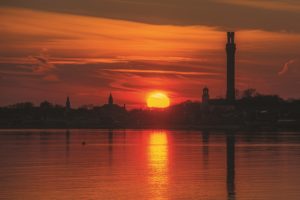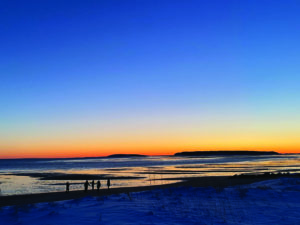Every evening, just before dark, a miracle occurs. You can go see it, and each time you do, it will be infinitely different from the last time you watched it. You’ll know to look west. There, the sky becomes a rich orange-red, and the clouds turn the most amazing array of colors.
These drifting bodies twist and billow on an invisible wind and express every texture and shape you’ve ever imagined — sometimes they even take the form of animals.
Gently, slowly, the light keeps changing. The entire composition is alive, moving in time like some cosmic symphony. Sometimes, stars appear.
It is traditional for us humans to watch sunsets. I suspect that’s always and everywhere been so. On the Outer Cape, it is something we do more often in winter. It is something to do. Besides, our days are short, and we crave the connection to light. And watching feels like a way of appreciating the day, like an act of gratitude.

I like to go to the bay, where I can sit in my truck on the coldest days and watch the miracle unfold over the water. The water adds another dimension to the show, becoming a mirror to the sky, as if to say, “Look how beautiful you are!”
The miraculous part, it seems to me, is in the ingredients that must come together to create a sunset — the Sun, the clouds, the atmosphere. You.
The Sun is a giant, nearly perfect ball of hot plasma, heated to incandescence by nuclear fusion. It is about 864,000 miles in diameter, it contains more than 99 percent of the total mass of the solar system, it is 93 million miles away, and it is the energetic source of all life. I mean, there’s a giant flaming ball somewhere far off in the great void of space, and it happens to be at the center of a solar system — the one you’re in, and, subsequently, at the center of your very existence.
Clouds are visible masses of water vapor floating in the atmosphere. Big, drifting bodies of water billowing through the sky. They appear white, reflecting back the full spectrum of the Sun’s light.
Clouds float, like oil on water, because the moist air within them is less dense than the dry air below. They can contain tons of water. It seems like a ridiculous thing to say, but the average cloud weighs 1.1 million pounds. Clouds hold all this water until it condenses and falls to Earth as rain. Along with the Sun, water is a key ingredient in the creation of life, an element central to your existence.
A layer of gases held close by Earth’s gravity surrounds the entire sphere we call home. The atmosphere is full of particles, debris, and gases — mostly nitrogen, oxygen, and carbon dioxide. Its interaction with the Sun’s light is responsible for the rich color palette we see at day’s end. As the light passes through this layer at a low angle, the shorter wavelengths — the blues and greens — are scattered and diffused. What remains are the yellows, the reds, and the oranges. Our atmosphere is where we spend our time. In it is the air we breathe. It contains the ingredients of life, and therefore, the very things from which you are composed.

When you watch the sunset, you are, in essence, watching the very miracle of your own existence. Just as the sea is a mirror to the sky, saying, “Look how beautiful you are,” the sunset is your mirror, reflecting you back at yourself, giving you an opportunity to acknowledge just how miraculous you are.
Witnessing this daily phenomenon, you see the universe in perfect alignment: galaxies spin, planets roll in their great rotations, stars are born and die, providing the material for new endeavors. All is running perfectly.
Who am I, you might ask, to decide, because I spilled coffee on the center console of my truck this morning, that today is a bad day? There is comfort in this insignificance. There is also a sense of responsibility in the absolute unlikelihood of our existence. We are both completely irrelevant and the most important thing that has ever existed.



